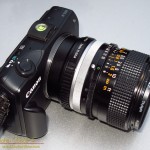One of the advantages of a mirrorless camera, like the EOS-M, is the very shallow backfocus requirement. The distance from the lens mount to the sensor is quite small, allowing use of just about any series of lenses on the market. All that is needed is the correct adapter, a need that several specialty manufacturers have addressed with products. The result is that the camera is useful in a wide range of photographic experiments and projects.

Any sort of zoom lens need not apply, the quality of the older zoom lenses often suffered. Designed without the aid of modern optical design software and without aspheric elements these designs fall short of modern standards.
You can find these classic lenses languishing on shelves in the back of camera stores, in garage sales and on eBay. There is a lot of junk out there, it takes some research to differentiate the good from the bad. A couple quick rules of thumb will sort out most of the junk… Stick to a first rank name in old camera gear; Canon, Nikon, Ziess, Hasselblad, and Leica. The next hint of a hidden gem is the focal ratio. The classic primes were fast, f/2.8 or faster. Still, it is wise to look up the history of the lens before plunking down any cash. The good lenses will be well written about, even in modern times. You will find good references with a quick web search.
I have a number of these excellent lenses, the fast primes once treasured by photographers for their optical quality. Mounting one of these pieces of glass on the front on a modern digital camera can be a lot of fun. For me it reminds me of the days when I was learning photography, back in the age of manual focus and film.
Some of my favorites include the Canon 100mm f/2.8, or the Nikon 105mm f/2.8. I also have the Nikon 180mm f/2.8 ED and a Canon 24mm f/2.8 that I enjoy using. Giving life to these old lenses can be rewarding. Using this old glass one gains an appreciation for the classic engineering and the photographers who used these lenses to capture so many beautiful images.

Focusing can be tricky. Many digital cameras do not offer the features once found to handle quick focusing of manual lenses. Gone are the split prism focusing screens and rangefinding viewfinders. You have to judge focus on the live view LCD. This is easy if the situation is static. But if things are moving quickly you will be faced with a challenge. Keep your depth of field deep or take a few shots to make sure you got it.
Aperture is also manual, the modern camera having no lever to actuate the aperture mechanism. Most adapters have a ring that will open and close the aperture, stopping the lens down to the setting on the dial or allowing full open. I often focus full open, using the shallow depth of field to set my focal point. I can then stop the camera down if desired, allowing the camera’s shutter speed and possibly automatic ISO selection to expose the shot properly.
There is limit to the use of old lenses. Designed for film these vintage lenses were specified to resolve details appropriate for fine grained film. The latest generation of digital high megapixel cameras have exceeded this level of detail by substantial margin. Cameras that feature pixel counts much above 20Mpix are probably not going to benefit in the use of old glass.
Another fun addition to the setup is an extension tube. This allows macro-photography, potentially reaching magnifications of 1:1 allowing insects and other small subjects to be easily photographed. Since macro-photography is usually a very manual setup involving a tripod or other camera mount and slow adjustments, the manual nature of the old lens is of little issue. One of my favorite combinations here is the Canon 100mm f/2.8 with a 25mm extension tune. The combination offers high magnification with a generous working distance of well over a foot from the subject.
If you have a mirrorless camera and a few old classic lenses about, spend a few dollars on an adapter to put the two together. It can be a rewarding experiment.


It’s worth noting that many mirrorless cameras offer “zebra strips” which assist with manual focusing. It highlights areas of the image that have achieved peak focus.
I’m not sure if the Canon M system has focus peaking, but basically every other mirrorless manufacturer offers the feature.
The EOS-M also features a focus peaking function, highlighting edges that are in focus with a selectable color. It works fairly well, but I do miss the utility of the focus screens used by the old SLRs.